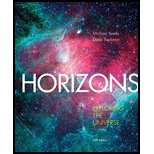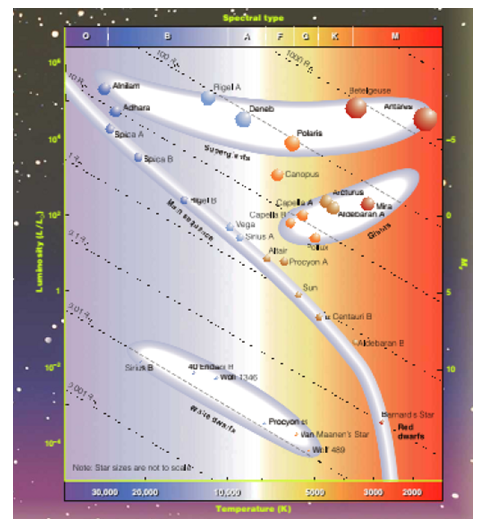
Concept explainers
- Which star is brightest?
- Which star is most luminous in absolute magnitude?
- Which star is largest?
- Which star is farthest away?
Answer to Problem 10P
- The brightest star is a.
- The most luminous star in absolute magnitude is c.
- The largest star is c.
- The farthest away star is d.
Explanation of Solution
Given:
Table
| Star | Spectral type | |
| a | G2 V | 5 |
| b | B1 V | 8 |
| c | G2 Ib | 10 |
| d | M5 III | 19 |
| e | White dwarf | 15 |
Formula used:
Absolute magnitude of the star is given as

Calculation:
Consider the H-R diagram

Figure.1
(a)
The classification of the star is G2 V, here G suggests that class of the star, and V suggest that it is a main sequence star. By the help of this we can estimate the absolute magnitude of the star using H-R diagram
It is clear from the figure that the absolute magnitude of the star is 5
Apparent magnitude of the star is give as
Plugging the values in the above equation
(b)
The classification of the star is B1 V, here B suggests that class of the star, and V suggest that it is a main sequence star. By the help of this we can estimate the absolute magnitude of the star using H-R diagram
It is clear from the figure that the absolute magnitude of the star is -1
Apparent magnitude of the star is give as
Plugging the values in the above equation
(c)
The classification of the star is G2 Ib, here G suggests that class of the star, and Ib suggest that it is supergiant star. By the help of this we can estimate the absolute magnitude of the star using H-R diagram
It is clear from the figure that the absolute magnitude of the star is -7
Apparent magnitude of the star is give as
Plugging the values in the above equation
(d)
The classification of the star is M5 III, here G suggests that class of the star, and III suggest that it is giant star. By the help of this we can estimate the absolute magnitude of the star using H-R diagram
It is clear from the figure that the absolute magnitude of the star is 0
Apparent magnitude of the star is give as
Plugging the values in the above equation
(e)
The absolute magnitude of the white dwarf is always greater or equal to 10.
Apparent magnitude of the star is give as
Plugging the values in the above equation
Thus, it is clear that, brightest star in apparent magnitude is a, most luminous absolute magnitude star is c, largest star is c because it is a supergiant star, and farthest away star is d.
Conclusion:
- The brightest star is a.
- The most luminous star in absolute magnitude is c.
- The largest star is c.
- The farthest away star is d.
Want to see more full solutions like this?
Chapter 8 Solutions
Horizons: Exploring the Universe (MindTap Course List)
- An oil slick on water is 82.3 nm thick and illuminated by white light incident perpendicular to its surface. What color does the oil appear (what is the most constructively reflected wavelength, in nanometers), given its index of refraction is 1.43? (Assume the index of refraction of water is 1.33.) wavelength color 675 × nm red (1 660 nm)arrow_forwardA 1.50 μF capacitor is charging through a 16.0 Ω resistor using a 15.0 V battery. What will be the current when the capacitor has acquired 1/4 of its maximum charge? Please explain all stepsarrow_forwardIn the circuit shown in the figure (Figure 1), the 6.0 Ω resistor is consuming energy at a rate of 24 J/s when the current through it flows as shown. What are the polarity and emf of the battery E, assuming it has negligible internal resistance? Please explain all steps. I know you need to use the loop rule, but I keep getting the answer wrong.arrow_forward
- If you connect a 1.8 F and a 2.6 F capacitor in series, what will be the equivalent capacitance?arrow_forwardSuppose that a particular heart defibrillator uses a 1.5 x 10-5 Farad capacitor. If it is charged up to a voltage of 7300 volts, how much energy is stored in the capacitor? Give your answer as the number of Joules.arrow_forwardThe voltage difference across an 8.3 nanometer thick cell membrane is 6.5 x 10-5volts. What is the magnitude of the electric field inside this cell membrane? (Assume the field is uniform, and give your answer as the number of Volts per meter... which is the same as the number of Newtons per Coulomb.)arrow_forward
- Three identical capacitors are connected in parallel. When this parallel assembly of capacitors is connected to a 12 volt battery, a total of 3.1 x 10-5 coulombs flows through the battery. What is the capacitance of one individual capacitor? (Give your answer as the number of Farads.)arrow_forwardSuppose you construct your own capacitor by placing two parallel plates at a distance 0.27 meters apart. The plates each have a surface area of 0.64 square meters. What is the capacitance of this setup? (Give your answer as the number of Farads.)arrow_forwardDraw a diagram with the new arrows. No they do not point all towards the center.arrow_forward
- Example In Canada, the Earth has B = 0.5 mŢ, pointing north, 70.0° below the horizontal. a) Find the magnetic force on an oxygen ion (O2) moving due east at 250 m/s b) Compare the |FB| to |FE| due to Earth's fair- weather electric field (150 V/m downward).arrow_forwardFour charges, qa, qb, qa, and qd are fixed at the corners of a square. A charge q that is free to move located at the exact center of the square. Classify the scenarios described according to the force that would be exerted on the center charge q. Assume in each case that q is a positive charge. Do not assume that the fixed charges have equal magnitudes unless the scenario defines such an equality. qa Яс q %b Force is zero Force is to the left Force is to the right Force is undeterminedarrow_forwardCharge qi = -q is located at position (0, d). Charge q = −2q₁ is located at position (d,0). Charge q3 = located at position (2d, 2d). 5qi is y Determine the net electric field Ĕ net at the origin. Enter your expression using ij unit vector notation in terms of the given quantities, the permittivity of free space €0, and exact rational and irrational numbers. d 9₁ d TH net = 92 d d Xarrow_forward
 Foundations of Astronomy (MindTap Course List)PhysicsISBN:9781337399920Author:Michael A. Seeds, Dana BackmanPublisher:Cengage Learning
Foundations of Astronomy (MindTap Course List)PhysicsISBN:9781337399920Author:Michael A. Seeds, Dana BackmanPublisher:Cengage Learning Stars and Galaxies (MindTap Course List)PhysicsISBN:9781337399944Author:Michael A. SeedsPublisher:Cengage Learning
Stars and Galaxies (MindTap Course List)PhysicsISBN:9781337399944Author:Michael A. SeedsPublisher:Cengage Learning Horizons: Exploring the Universe (MindTap Course ...PhysicsISBN:9781305960961Author:Michael A. Seeds, Dana BackmanPublisher:Cengage Learning
Horizons: Exploring the Universe (MindTap Course ...PhysicsISBN:9781305960961Author:Michael A. Seeds, Dana BackmanPublisher:Cengage Learning AstronomyPhysicsISBN:9781938168284Author:Andrew Fraknoi; David Morrison; Sidney C. WolffPublisher:OpenStax
AstronomyPhysicsISBN:9781938168284Author:Andrew Fraknoi; David Morrison; Sidney C. WolffPublisher:OpenStax Stars and GalaxiesPhysicsISBN:9781305120785Author:Michael A. Seeds, Dana BackmanPublisher:Cengage Learning
Stars and GalaxiesPhysicsISBN:9781305120785Author:Michael A. Seeds, Dana BackmanPublisher:Cengage Learning





